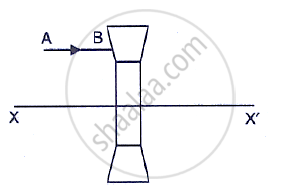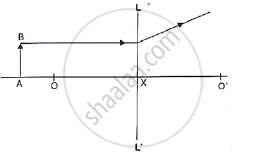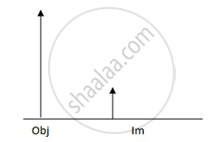Advertisements
Advertisements
प्रश्न
A ray of light incident at the optical centre of lens, passes undeviated after refraction.
विकल्प
True
False
उत्तर
This statement is true.
APPEARS IN
संबंधित प्रश्न
State the condition when a lens is called an equi-convex or equi-concave.
The diagram below shows a lens as a combination of a glass slab and two prisms.
- Name the lens formed by the combination.
- What is the line XX’ called?
- Complete the path of the incident ray AB after passing through the lens.
- The final emergent ray either meets XX’ at a point or appears to come from a point on XX’. Label it as F. What is this point called?

Study the diagram shown in Fig. 5.56
what are the two other characteristics of the image?

For an object placed at a distance 20 cm in front of a convex lens, the image is at a distance 20 cm behind the lens. The focal length of the convex lens is ______.
(a) Draw a sketch to show how a lens is able to produce an image of the sun on a paper screen.
(b)(i) Would you regard the rays from the sun as being divergent, parallel or convergent?
(ii) What is the name given to the point where such rays meet after they have passed through the lens?
(iii) How does the image of the sun sometimes burn a paper screen?
What type of lenses are used in spectacles worn by an old lady for knitting?
In the following diagram the object and the image formed by the respective lenses are shown. Complete the ray diagram, and locate the focus. Find the focal length of the lens.

In the following diagram , the object and the image formed by the respective lenses are shown. Complete the ray diagram, and locate the focus. Find the focal length of the lens.

In the following diagram , the object and the image formed by the respective lenses are shown. Complete the ray diagram, and locate the focus. Find the focal length of the lens.

State the nature and position of the object on the principal axis to obtain a real and magnified image.
